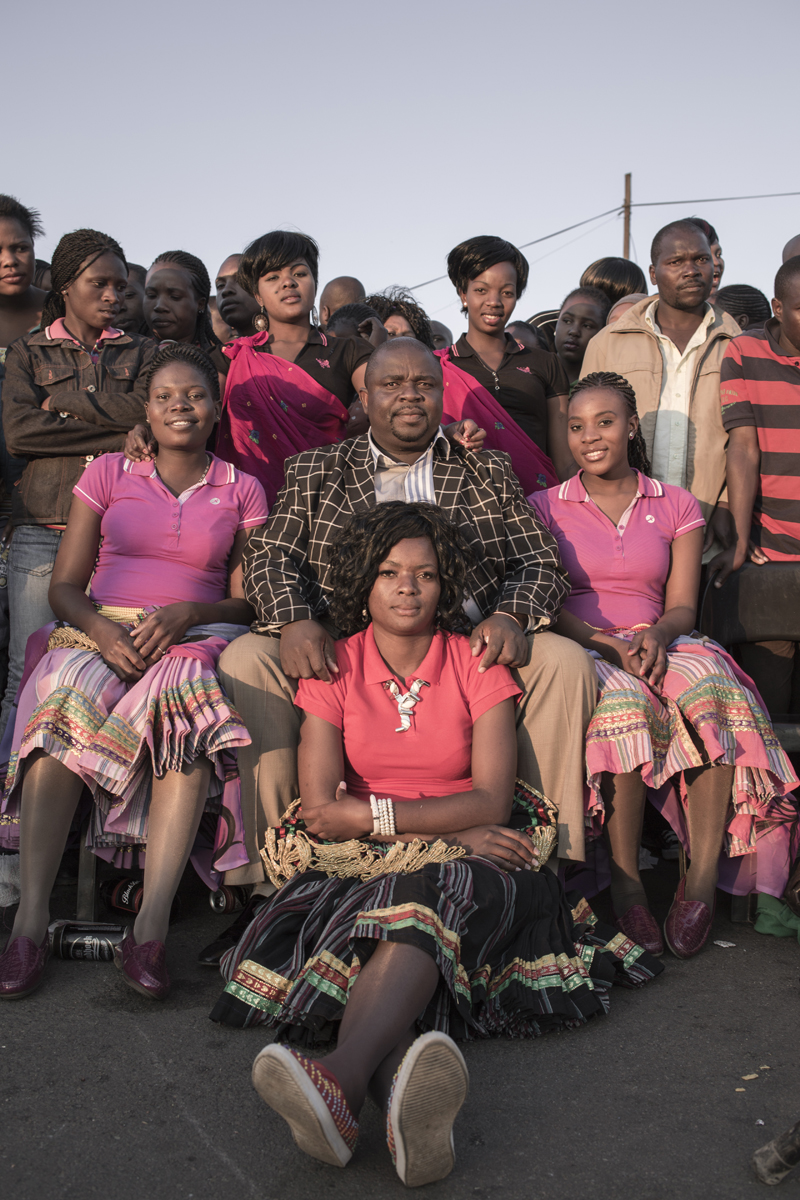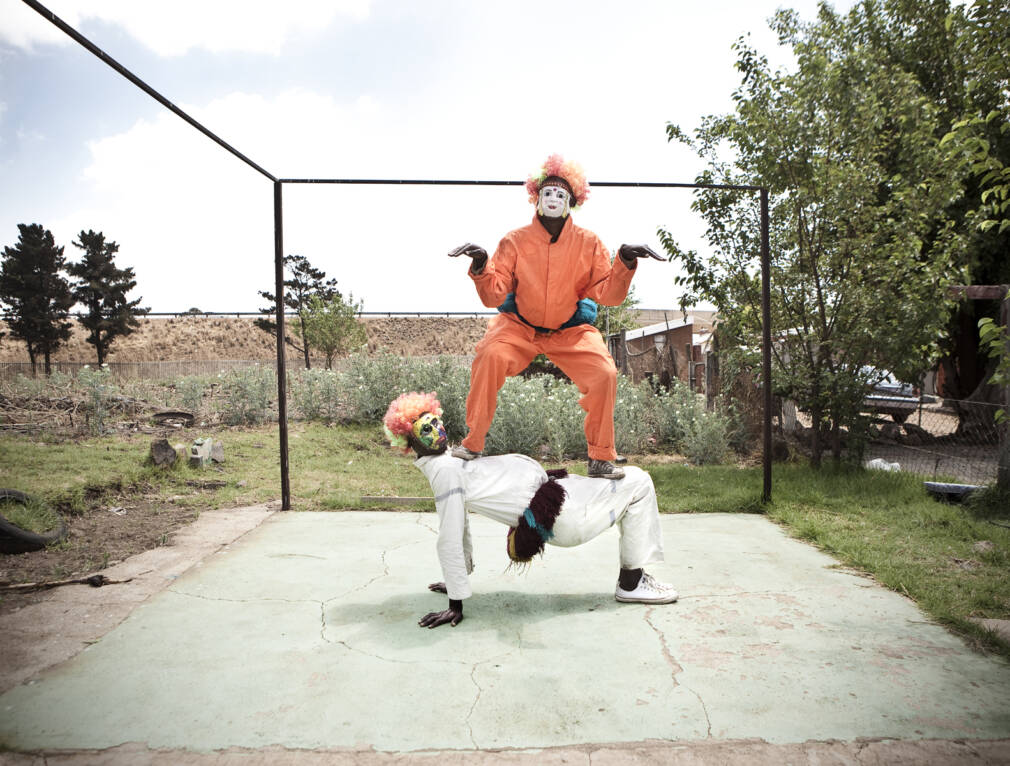Hyper-fast electronic beats race in pace with synthesized pan flutes and marimbas, overlayed with festive call-and-response chants. Hand claps and chipmunked vocal snippets complete the broiling stew. On hard dirt lots, surrounded by crowds of onlookers, giant-butted clowns dance manically, kicking and stomping to the cartoonishly jubilant, psychedelic music. This is (or was) Shangaan electro.
In South Africa’s Limpopo region, Shangaan electro (locally known as Tsonga electro) was birthed around 2005, and in half a decade it had bubbled up into a worldwide phenomenon. Fiercely unique, challenging, and indifferent to popular convention, it was embraced enthusiastically by daring listeners all over. But half a decade later, with only a handful of releases reaching the international market, Shangaan electro had seemingly vanished.
Its name derived from the Shangaan tribe, which comprises part of southern Mozambique and South Africa’s Tsonga population, the earliest Shangaan electro release of record is MC Mabasa’s album, Ku Tekiwa · Manana Mabasa Na Shigombe Sisters (1997), although older, poorly documented releases likely exist, and Shangaan music in general dates back to antiquity.
Between its undefined folk origins and its emergence in the mid-00s, Shangaan electro built upon foundations established by a succession of fundamental shifts throughout the latter 20th century. In the early 60s, the introduction of western instruments, especially guitars, to rural Zulu music, spawned “mbaqanga,” with its more westernized offshoot “township jive,” both of which were eclipsed in the late 70s and early 80s by “Tsonga disco,” which incorporated sped-up R&B basslines and other elements of then-internationally-popular dance music. In the 90s “Kwaito house” allowed four-on-the-floor drum machine rhythms and synthesizers to take center stage. Throughout the decades, sung and chanted vocals ranging from call-and-response groups to soloists remained in the forefront. Tsonga disco and Kwaito house maintain a strong presence to this day, having transformed over the years with the advent of new production technologies and the sounds of contemporary pop, R&B, hip hop, dancehall and beyond, spawning various subgenres along the way such as “gqom” and “amapiano.”
What differentiated Shangaan electro from the preceding popular forms in the region was its speed (reaching tempos up to 190 bpm) and the absence of bass lines or heavy kick drums. This accentuation of mids and highs, along with the complexity of the drum patterns, gave the music a lightness and busyness conducive to euphoria and ultra-fast leg-and-foot-centered dances.
Another undeniable through-line of Shangaan electro is Nozinja. The vast majority of the genre’s releases include the Limpopo-born artist as composer, producer, engineer, and/or label owner, and he’s said to have coined the term. With his label, Nozinja Music, and by organizing live events, he popularized the music throughout Soweto. And starting in 2010, with the help of London’s Honest Jon’s Records, Shangaan electro was propelled worldwide, with Nozinja as mouthpiece for Shangaan music and culture in a torrent of interviews and documentaries that crescendoed around 2015.

Beside Nozinja, another important contributor to the genre was DJ Khwaya. Though he didn’t ride the media wave or release work on Nozinja Music or Honest Jon’s, and therefore remained virtually unknown to international audiences, Khwaya’s music was extremely popular within South Africa, and he was one of the first artists doing what would later be called Shangaan electro. Khwaya remains active in the Johannesburg music scene to this day.
As European club scenes widely embraced African and South American electronic dance strains, and “global bass” was adopted as a catch-all term for complex cross-pollinations of African, Latin American, and Caribbean trends in the late 2000s and early 2010s, Nozinja and his cohorts were skyrocketing. The former cell phone repairman was headlining international festivals and his debut solo album, Nozinja Lodge, came out to widespread critical acclaim on electronic mainstay, Warp Records. But by late 2015, Nozinja and most of his contemporaries had seemingly just stopped. As for what accounted for this abrupt silence, there is no official word. The many artists and labels contacted for this interview have not responded for comment.
Over the next several years, Europe and the wider western world continued its obsession with futuristic tribal musics like moombahton, electro-cumbia, and other techno-tropical iterations, but journalists quit writing about Shangaan music. Maybe listeners just lost interest, or it was too specific a musical recipe to be adopted and transformed by overseas producers. Whatever the case, Nyege Nyege Tapes had sprung up, popularizing new mutant African strains from Uganda, Tanzania and abroad, many of them featuring rhythms that eclipsed the speed and complexity of Shangaan electro. By 2017, from a casual glance, the trend had lost all relevancy and its artists had simply quit. But that’s not quite right.
Although Nozinja, Khwaya, Honest Jon’s, Warp, The Fader, Rolling Stone, and the rest of the world seemed to forget it was ever a thing, Shangaan electro has carried on, but in a much less visible fashion. Online, you’d be hard pressed to find active Shangaan electro musicians faithfully carrying on its traditions, with few exceptions (such as GT Sikiza). But rare and brief instances on TikTok and YouTube show that electro’s music and dancing is alive and well in its homeland, regardless of media attention. The aforementioned DJ Khwaya, while very much outside of the internet’s purview, can still be seen performing in Johannesburg alongside myriad artists working in the vein of Shangaan electro and its musical cousins. Shangaan electro’s influence can also be heard in gqom, Amapiano, Xigaza, and other popular music from the region.
Even singer and guitarist Thomas Chauke, possibly the single-most famous traditional South African musician of all time, who notoriously declared Shangaan electro and other forms of synthesized music “not music,” is currently playing at tempos unheard-of before Shangaan electro upped the ante, and includes an electronic keyboardist in his band.
Beyond Africa, Shangaan electro’s brief stint in the worldwide spotlight has imprinted its signatures into the general musical lexicon, with its subtle echoes destined to resound far into the future. While these influences may be difficult to discern, clear examples can be found in obscure Soundcloud experiments like Japanese producer Tobokegao’s “Shangaan Singeli Chiptune,” or “Shangaan hardstyle” by British producer Charge. And there’s also… ahem – my own album, Recombinant Shangaan, which I released as DJ 0.000001.

